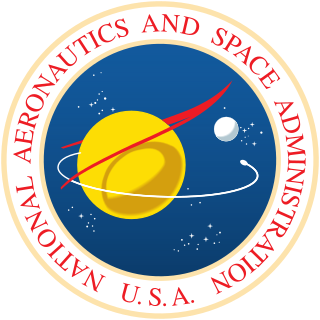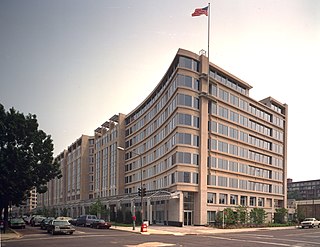Related Research Articles

The Apollo program, also known as Project Apollo, was the United States human spaceflight program led by NASA, which succeeded in landing the first men on the Moon in 1969, following Project Mercury, which put the first Americans in space. It was conceived in 1960 as a three-person spacecraft during President Dwight D. Eisenhower's administration. Apollo was later dedicated to President John F. Kennedy's national goal for the 1960s of "landing a man on the Moon and returning him safely to the Earth" in an address to Congress on May 25, 1961. It was the third US human spaceflight program to fly, preceded by Project Gemini conceived in 1961 to extend spaceflight capability in support of Apollo.

Pop art is an art movement that emerged in the United Kingdom and the United States during the mid- to late-1950s. The movement presented a challenge to traditions of fine art by including imagery from popular and mass culture, such as advertising, comic books and mundane mass-produced objects. One of its aims is to use images of popular culture in art, emphasizing the banal or kitschy elements of any culture, most often through the use of irony. It is also associated with the artists' use of mechanical means of reproduction or rendering techniques. In pop art, material is sometimes visually removed from its known context, isolated, or combined with unrelated material.

The Lyndon B. Johnson Space Center (JSC) is NASA's center for human spaceflight in Houston, Texas, where human spaceflight training, research, and flight control are conducted. It was renamed in honor of the late U.S. president and Texas native, Lyndon B. Johnson, by an act of the United States Senate on February 19, 1973.

Milton Ernest "Robert" Rauschenberg was an American painter and graphic artist whose early works anticipated the Pop art movement. Rauschenberg is well known for his Combines (1954–1964), a group of artworks which incorporated everyday objects as art materials and which blurred the distinctions between painting and sculpture. Rauschenberg was primarily a painter and a sculptor, but he also worked with photography, printmaking, papermaking and performance.

James Edwin Webb was an American government official who served as Undersecretary of State from 1949 to 1952. He was the second Administrator of NASA from February 14, 1961, to October 7, 1968. Webb led NASA from the beginning of the Kennedy administration through the end of the Johnson administration, thus overseeing each of the critical first crewed missions throughout the Mercury and Gemini programs until days before the launch of the first Apollo mission. He also dealt with the Apollo 1 fire.

The Vision for Space Exploration (VSE) was a plan for space exploration announced on January 14, 2004 by President George W. Bush. It was conceived as a response to the Space Shuttle Columbia disaster, the state of human spaceflight at NASA, and as a way to regain public enthusiasm for space exploration.

Lunar orbit rendezvous (LOR) is a process for landing humans on the Moon and returning them to Earth. It was utilized for the Apollo program missions in the 1960s and 1970s. In a LOR mission, a main spacecraft and a lunar lander travel to lunar orbit. The lunar lander then independently descends to the surface of the Moon, while the main spacecraft remains in lunar orbit. After completion of the mission there, the lander returns to lunar orbit to rendezvous and re-dock with the main spacecraft, then is discarded after transfer of crew and payload. Only the main spacecraft returns to Earth.

The Universities Space Research Association (USRA) was incorporated on March 12, 1969, in Washington, D.C. as a private, nonprofit corporation under the auspices of the National Academy of Sciences (NAS). Institutional membership in the association currently stands at 113 universities. All member institutions have graduate programs in space sciences or technology. Besides the 98 member institutions in the United States, there are two member institutions in Canada, four in Europe, two in Israel, one in Australia and one in New Zealand, one in Hong Kong, two in Korea and two in the United Kingdom.

Space art, also known as astronomical art, is a genre of art that visually depicts the universe through various artistic styles. It may also refer to artworks sent into space.

The National Aeronautics and Space Administration is an independent agency of the US federal government responsible for the United States' civil space program, aeronautics research and space research. Established in 1958, it succeeded the National Advisory Committee for Aeronautics (NACA) to give the US space development effort a distinct civilian orientation, emphasizing peaceful applications in space science. It has since led most of America's space exploration programs, including Project Mercury, Project Gemini, the 1968–1972 Apollo Moon landing missions, the Skylab space station, and the Space Shuttle. Currently, NASA supports the International Space Station (ISS) along with the Commercial Crew Program, and oversees the development of the Orion spacecraft and the Space Launch System for the lunar Artemis program.
The Foundation for Contemporary Arts (FCA), is a nonprofit based foundation in New York City that offers financial support and recognition to contemporary performing and visual artists through awards for artistic innovation and potential. It was established in 1963 as the Foundation for Contemporary Performance Arts by artists Jasper Johns, John Cage, and others.

The Mary W. Jackson NASA Headquarters building at 300 E Street SW in Washington, D.C. houses NASA leadership who provide overall guidance and direction to the US government executive branch agency NASA, under the leadership of the NASA administrator. NASA Headquarters is organized into four Mission Directorates: Aeronautics, Exploration Systems, Science, and Space Operations. Ten field centers and a variety of installations around the country conduct the day-to-day work of the agency.
With the advent of robotic and human spaceflight a new era of American history had presented itself. Keeping with the tradition of honoring the country's history on U.S. postage stamps, the U.S. Post Office began commemorating the various events with its commemorative postage stamp issues. The first U.S. Postage issue to depict a U.S. space vehicle was issued in 1948, the Fort Bliss issue. The first issue to commemorate a space project by name was the ECHO I communications satellite commemorative issue of 1960. Next was the Project Mercury issue of 1962. As U.S. space exploration progressed a variety of other commemorative issues followed, many of which bear accurate depictions of satellites, space capsules, Apollo Lunar Modules, space suits, and other items of interest.

Moon Museum is a small ceramic wafer three-quarters by one-half inch in size, containing artworks by six prominent artists from the late 1960s. The artists with works in the "museum" are Robert Rauschenberg, David Novros, John Chamberlain, Claes Oldenburg, Forrest Myers and Andy Warhol.

Paul Calle was an American artist who was best known for the designs he created for postage stamps, including 40 that were released by the United States Postal Service, and others for stamps issued by the Federated States of Micronesia, the Marshall Islands, Sweden and the United Nations. The sole artist hired by NASA to cover the Apollo 11 astronauts up close, Calle designed the 10-cent stamp that commemorated the first crewed Moon landing; it depicted an astronaut stepping onto the Moon from the lunar module, with the Earth visible over the Moon's horizon.

Address at Rice University on the Nation's Space Effort, commonly known by the sentence in the middle of the speech "We choose to go to the Moon", was a speech on September 12, 1962, by John F. Kennedy, the President of the United States. The aim was to bolster public support for his proposal to land a man on the Moon before the end of the decade and bring him safely back to Earth. Kennedy gave the speech, largely written by presidential advisor and speechwriter Ted Sorensen, to a large crowd at Rice University Stadium in Houston, Texas.

Apollo 11 was the first human spaceflight to land on the Moon. In the decades after its 1969 mission took place, widespread celebrations have been held to celebrate its anniversaries.
David Ross Novros, is an American artist. He is known for his minimalist geometric paintings, shaped canvases, and his use of color. He has also studied fresco painting extensively.
References
- ↑ "Soaring: Works from the NASA Art Program, Celebrating NASA Langley's Centennial Anniversary". pfac-va.org. Peninsula Fine Arts Center. Retrieved 1 October 2018.
- 1 2 Bert, Ulrich. "NASA and the Arts".
- ↑ Meier, Allison (29 August 2013). "Art in the Outer Limits: A Look at NASA's Space Art Program". hyperallergic.com. Hyperallergic. Retrieved 1 October 2018.
- ↑ Goodyear, Anne Collins, The Relationship of Art to Science and Technology in the United States, 1957-1971: Five Case Studies, ProQuest 305503573
- 1 2 3 4 Hotovy, Hannah (2017-04-12). "NASA and Art: A Collaboration Colored with History". NASA. Retrieved 2018-11-06.
- 1 2 3 4 5 6 Collins, Anne. "Art, technology, and the American space program, 1962-1972". go.galegroup.com.ccclibrary.idm.oclc.org. Retrieved 2018-11-06.
- 1 2 3 Siceloff, Steven (15 May 2009). "NASA - Artists Give NASA a Different Light". www.nasa.gov. Retrieved 2018-11-06.
- 1 2 3 4 5 6 7 8 9 10 11 "nasaartspace". Flickr. Retrieved 2018-11-06.
- ↑ Cooke, Hereward Lester (1972). Eyewitness to Space. New York: Harry N. Abrams, Inc. p. 227. Bibcode:1971ets..book.....C.
- ↑ Marta Wiktoria Bryll, Eyewitness to Space: The NASA Art Program, dailyartmagazine.com, 12 April 2022
- ↑ Fox, Margalit (31 December 2010). "Paul Calle, Postage Stamp Designer, Is Dead at 82". The New York Times. Retrieved 2018-11-06.
- ↑ Schmid, Beth (September 29, 1988). "NASA's Art Program Captures What the Camera Can't". NASA Magazine (Spring 1992): 11–17. Retrieved 1 October 2018.
- ↑ Schulman, Robert (1988). Visions of flight : a retrospective from the NASA Art Collection. United States. National Aeronautics and Space Administration (NASA). p. 3. Retrieved 1 October 2018.